► A very special test drive for new 4×4
► However, the Grenadier is delayed
► Customers and dealers praised for patience
Following swiftly on from no less than two former F1 champs driving the new Lotus Evija, the Ineos has revealed that the Grenadier 4×4 has recently been put through its paces by none other than Sir Lewis Hamilton.
You can watch the seven-times Formula 1 world champion driving the Ineos Grenadier on video below – and then read on to find out everything there is to know about this intriguing new off-roader, which we’ve been following since its inception.
An intriguing mix of old-school looks and reparability with new-school technology – largely borrowed from BMW – the much-anticipated Ineos Grenadier has finally gone into production, with the first customer car leaving the new automotive brand’s factory at Hambach in France on 17 October 2022.
Has the Ineos Grenadier been delayed?
As recently as April 2022, the company founded by industrialist Sir Jim Ratcliffe was anticipating that series production would start in July, having previously targeted late 2021.
But even Sir Jim’s petro-chemical billions couldn’t find a way around the delays dogging the whole car industry, caused chiefly by a combination of knock-on effects from Covid, shortages of semiconductors and the disruption to supply chains caused by the Russian invasion of Ukraine.
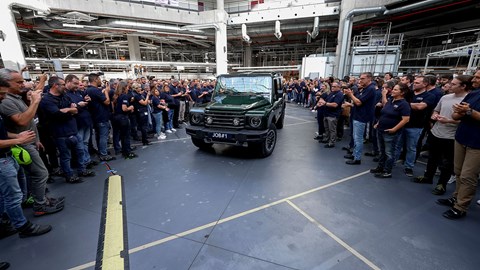
‘Designing, engineering, building prototypes is one thing – but productionising is quite another. That’s where the tough stuff happens in the industry, and God it’s been tough, I have to say,’ Ineos Automotive commercial director Mark Tennant told CAR.
‘We’ve had all sorts of challenges – the challenges of bringing Grenadier into albeit a great facility at Hambach, but then overlaying on that all the difficulties that we’re having in common with the rest of the industry, in terms of supply-chain issues, suppliers in Russia, all sorts of things we’ve had to contend with, over and above.’
He added: ‘Those supply-chain issues in particular aren’t done with. So we’re going to be ramping up very gently, to make sure we don’t create problems for ourselves in lots of line stops if things don’t turn up in the volumes we expect, because it continues to be a frustration. We won’t actually start delivering volume until early December – that’s when things will start to ramp up, when we can see some light at the end of the tunnel. Everything crossed, and hoping for following winds, because it ain’t easy.’
It still feels like the Grenadier has come out of nowhere, fast, though?
Even with these unavoidable hiccups, the creation of the rugged 4×4 from nothing has been completed unusually quickly, from Ratcliffe’s first public announcement in February 2017. It’s a clean-sheet design, available in two- and five-seat Utility versions and as a five-seat Station Wagon, with a pick-up soon to follow and a short-wheelbase version likely. Electric and hydrogen possibilities for the future are also being explored. The intial target, once production is up to full speed, is 30,000 Grenadiers a year.
The Grenadier comes with a choice of 3.0-litre petrol or diesel engine supplied by BMW, and many other components are provided by outside suppliers. ‘They in turn have their challenges,’ said Tennant. ‘They have their raw-material shortages, if you go to the most basic end of the spectrum, through to the most sophisticated componentry. I don’t think we’re any different to anybody else, other than the fact that we’re the newbies; we’ve also been building this car company.
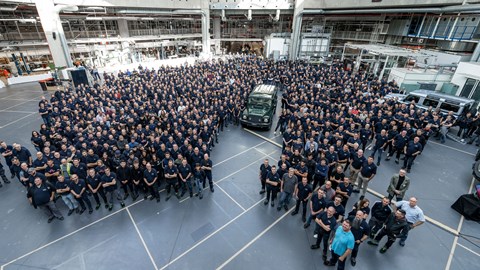
‘We’re going to keep on planning and re-planning. We’ve done quite a lot of resourcing, so we’re not afflicted by what’s going on to the east of us. Covid, in terms of shutdowns in China, like everybody that’s been a problem. Things have opened up a bit, they have eased, but it’s a full-time job being on the planning side.’
He said customers had been understanding. ‘We have got some very patient, very enthusiastic customers. We are absolutely thrilled with the level of engagement. They are very understanding. They are seeing the big picture on the wider industry. So to some extent it’s assumed that there will be the odd delay.
‘We really don’t want to test the patience. But the general feedback is: get it right, guys. Get the qualty right. We can afford to wait. We’ve been waiting a while anyway because of the build-up we’ve had over a few years now. Just get it right and bring it to us when you’re ready. That’s never to be taken for granted, but so far, so good.’
Dealers had also accepted that Ineos was doing everything it could. ‘We’ve got the signage going out to them, we’re doing the training for their people, so there’s lots to be getting on with.’
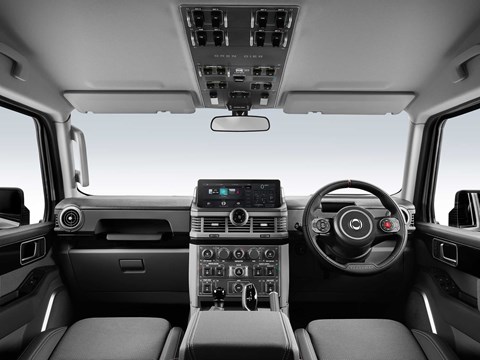
‘There’s been quite high uptake around the world on the Trialmaster and Fieldmaster Belstaff editions with the higher spec. The Trialmaster is the more 4×4 focused, with the three diff locks. The Fieldmaster’s a little bit more comfy. Generally quite a high uptake on those. It varies around the world – more utilitarian in Australia, for example.’
Was there a silver lining to the delays? ‘Doing quality loops and having more time for the vehicle to be matured is never a bad thing,’ said Tennant. ‘There are always going to be issues to be fixed, and that has been useful. I’d much rather not have needed the sliver lining and be moving forward more quickly.
‘But all time is useful, in terms of let’s go through the process one more time. The quality centre at Hambach, the destructive testing we can do to check on the integrity of the body. There’s always going to be refinement.’
Everything you need to know about the Ineos Grenadier
Using six-cylinder BMW engines, and developed with 4×4 specialists Magna, the British company’s first car is being built at the Hambach factory, taken over by Ineos in January 2021. First sales will be in the UK and Europe, with North America following in 2023.
More than 130 ‘2B’ prototypes completed cold-weather and high-altitude testing in the Alps, Sweden and Iceland, before moving to hot-weather evaluation in Namibia, South Africa, the Middle East and the USA. The target was to complete more than a million test miles, on road and off, before production began.
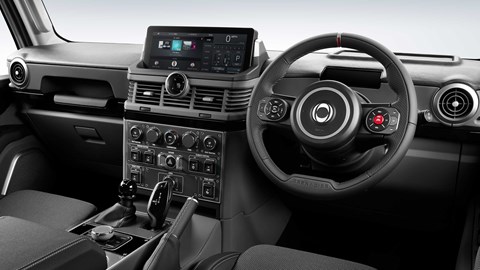
Sir Jim himself drove a Grenadier up the Schöckl mountain near the Graz HQ of Ineos Automotive’s development partner Magna, and declared himself pleased with progress: ‘We’ve made great strides since the very early versions of the Grenadier I drove a year ago. The Schöckl is a proper challenge for any 4×4. Today was a real test for our prototypes, and they came through very well. There is still work to do, but I am confident that the Grenadier will do the job we have developed it for.’
The suspension geometry has been tweaked as a result of off-road testing, and work is continuing on the airbags after some intensive crash testing. Engineers are happy with the cold-weather calibration of the Grenadier’s BMW engines, but Death Valley and southern Africa will bring a fresh set of challenges.
After the Schöckl test, Ineos Automotive chief executive Dirk Heilmann said: ‘Reaching this important development milestone is a great step forward for the project. We only have one opportunity to get this right and our quality and performance targets for the Grenadier remain paramount. We won’t cut corners.’
From the off, the Grenadier was always going to have a traditional box-section ladder frame, with beam axles, permanent four-wheel drive, lockable diffs and internal combustion engines.
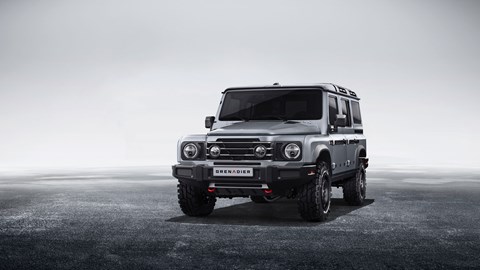
Says commercial director Mark Tennant: ‘Number one focus was off-road mobility and capability. An off-road vehicle that doesn’t keep on going and providing years of faithful service isn’t really doing the job. It’s got to get you out into the bush and back again.
‘It’s a vehicle designed first and foremost to be a working tool. Not everybody is going to work it as hard as some of the really exacting requirements some of our customers will have, but it’s got to be capable of that.
‘You shouldn’t have to suffer, you shouldn’t be in any pain for having a utilitarian vehicle. In terms of connectivity, screens, seat comfort, room – that’s all built in. It’s not a throwback. It’s a modern vehicle built to a certain style.’
Ramp up the rugged
The styling has a level of butchness not strictly required by the ‘form over function’ ethos. It’s very boxy, with prominent wheelarches, low-ish bonnet, near-flat glass, external door hinges, rubbing strip/utility rail along the sides, asymmetrical rear doors, a ladder to the roof, exposed tie bars, tow hooks front and rear, bash plates and steel wheels.
It looks a lot like a mix of Wrangler, Defender, G-Class and Jimny, not to mention the Ford Bronco.
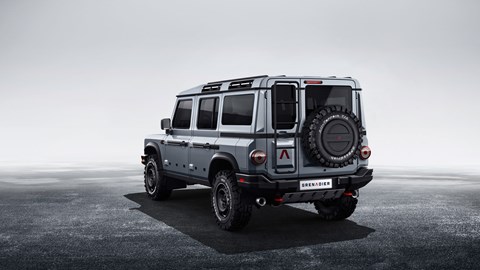
Design chief Toby Ecuyer says: ‘We looked at other 4x4s, we looked at tractors, helicopters, all sorts of different really hard-working vehicles, and took inspiration. Then we started designing this very honest, uncomplicated vehicle.’
Buy from the best
There are two engines, a petrol and a diesel, both 3.0-litre straight-sixes from BMW. Smartly, Ineos has a deal that covers the next generation of engines as well.
Transmissions are from ZF, axles from tractor-makers Carraro, and a lot of the development work has been done by Magna, the same people who make the G-Class for Mercedes.
The assembly process was originally intended to involve bodies and chassis being built in an Ineos plant in Portugal, before the cars were completed at the purpose-built factory in Bridgend, Wales. But the Portuguese and Welsh operations will now take place in France.
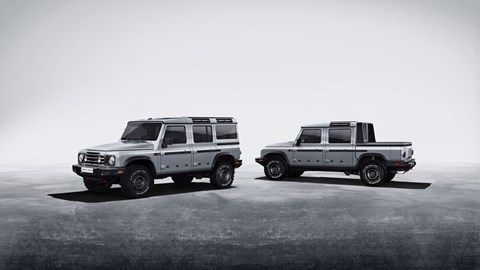
Tennant says: ‘Our peak volume we’re looking to deliver globally is in the region of 25,000 – a lot less than other manufacturers would be aiming for. That peak volume is some way off. We need a run-up. The key to this is a bit of humility and understanding that we’re not going to do it from day one.
‘We’re launching with internal combustion engines, because to deliver on the engineering blueprint we don’t think there’s another game in town right now, but like everybody we’re watching the development of technologies and infrastructure very closely.
‘What we’re doing is developing a new line of vehicles and developing a new vehicle company, a new OEM, from scratch. They’re both big investments. Ineos doesn’t do things by halves. Ineos Automotive will end up being a lot more than the Grenadier.’
Stay simple
Ecuyer explains how his team went about the job: ‘Our starting point was to collate our top utility vehicles. Also ones that had really proved themselves over the years. There was an honesty about them. There were certain words that kept coming up: assured, robust, faithful, dependable, purposeful. Whatever detail we were working on, did it tick any of these boxes?
‘Given our decision to go with a ladder chassis, a wheel in each corner, a big powerful engine and beam axles, that in itself already gives you some strict parameters to work within. We spent ages with the engineers testing wheel-travel angles, the exit and entry angles, getting all the mechanics right first, then we clad that, with this idea that you can see the structural themes running through, you can see how the doors are attached. Everything is very much on show.
‘The interior thinking is very much the same as the outside. All the electronics and essentials that you’d have in any other vehicle are there, but we’ve tried to do it in a very simple, uncomplicated, easily manageable way. All the switches you can operate wearing gloves.’
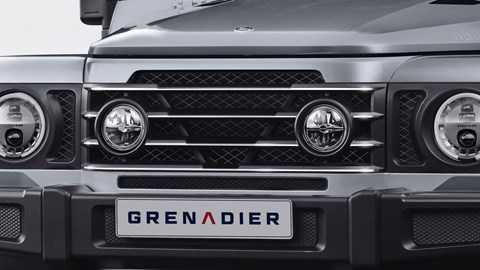
There won’t be many trim levels. But there will be a lot of options and accessories, and Ineos is working with aftermarket specialists to ensure they can offer good-quality bolt-ons.
Tennant: ‘We will have a range of accessories from the off, but we also want to be quite open-source, and allow people to affix existing accessories, to adapt things they already have in the garage to put on the vehicle. Hence the roof guttering allows people to, with minor mods, put an existing roof rack on as well as the one we will offer.
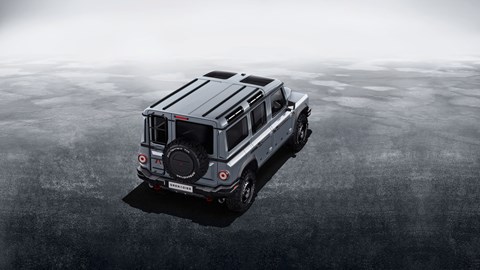
There isn’t a traditional dealer network as such – although there are 24 initial retailers signed up, with 10 more to follow by the end of 2022, there is a lot of online-first thinking as you can do pretty much everything at home on the configurator. This does mean that the price is fixed and you can’t go in and expect a discount off the asking price.
The first Grenadier will be this wagon, followed by a shorter-wheelbase version and a double-cab pick-up with an extended wheelbase.
Ineos Grenadier price and spec
Pricing is relatively simple and starts at £49,000 for the two-seater commercial vehicle version. There will also be a five-seat commercial version (big boot, small rear passenger area), which starts at £52,000 and a pair of Belstaff editions – the Fieldmaster and the Trialmaster, which both begin at £59,000. Interestingly there is no price difference between the petrol and diesel engines, which are both 3.0-litre straight-six BMW units.
There will also be a twin-cab pick-up version, which has a longer wheelbase – likely to pave the way for a seven-seat Station Wagon. This isn’t available to order yet, but you can register interest on the website.